Analyzing Westpac's Corporate Social Responsibility Reporting
VerifiedAdded on 2023/06/07
|10
|2281
|89
Report
AI Summary
This report provides an overview of Westpac Bank's corporate social responsibility (CSR) initiatives, analyzing their impact on stakeholders and the community. It discusses the various components of Westpac's CSR, including social, environmental, economic, ethical, and legal aspects, highlighting the bank's commitment to sustainability. The report critically analyzes Westpac's CSR reporting through the lens of stakeholder theory, emphasizing the importance of creating value for all stakeholders. It also examines the impact of CSR on the bank's reputation, consumer loyalty, and community relations, concluding that Westpac's CSR activities contribute significantly to social development and stakeholder satisfaction. Desklib offers a range of similar solved assignments and study resources for students.

Accounting Theory
Paraphrase This Document
Need a fresh take? Get an instant paraphrase of this document with our AI Paraphraser

Executive Summary
The report is about the corporate social responsibility of West. The report presented the
introduction of Westpac Bank. The components of CSR that are practiced in Westpac are
discussed in this report. This showed that the CSR activities of the bank are providing the
benefits to the society, its stakeholders, and the nation as well. CSR reporting is analyzed in
the report using stakeholder theory, which shows that the stakeholders are important for the
bank. The impact of CSR is also discussed which showed that the consumers are attracted
towards the bank because of the CSR activities. The bank is contributing in social
development in an effective manner through CSR activities.
The report is about the corporate social responsibility of West. The report presented the
introduction of Westpac Bank. The components of CSR that are practiced in Westpac are
discussed in this report. This showed that the CSR activities of the bank are providing the
benefits to the society, its stakeholders, and the nation as well. CSR reporting is analyzed in
the report using stakeholder theory, which shows that the stakeholders are important for the
bank. The impact of CSR is also discussed which showed that the consumers are attracted
towards the bank because of the CSR activities. The bank is contributing in social
development in an effective manner through CSR activities.
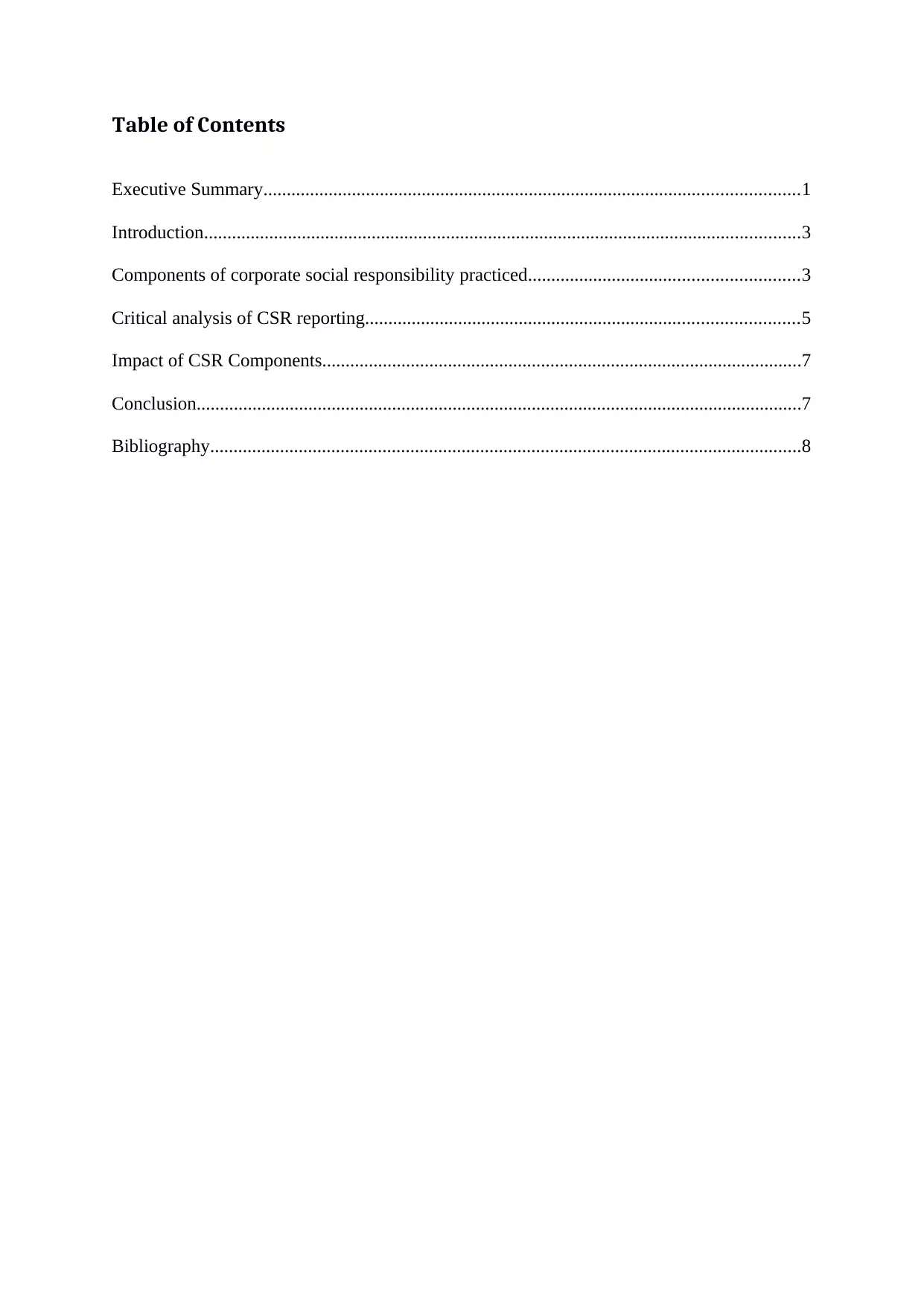
Table of Contents
Executive Summary...................................................................................................................1
Introduction................................................................................................................................3
Components of corporate social responsibility practiced..........................................................3
Critical analysis of CSR reporting.............................................................................................5
Impact of CSR Components.......................................................................................................7
Conclusion..................................................................................................................................7
Bibliography...............................................................................................................................8
Executive Summary...................................................................................................................1
Introduction................................................................................................................................3
Components of corporate social responsibility practiced..........................................................3
Critical analysis of CSR reporting.............................................................................................5
Impact of CSR Components.......................................................................................................7
Conclusion..................................................................................................................................7
Bibliography...............................................................................................................................8
⊘ This is a preview!⊘
Do you want full access?
Subscribe today to unlock all pages.

Trusted by 1+ million students worldwide
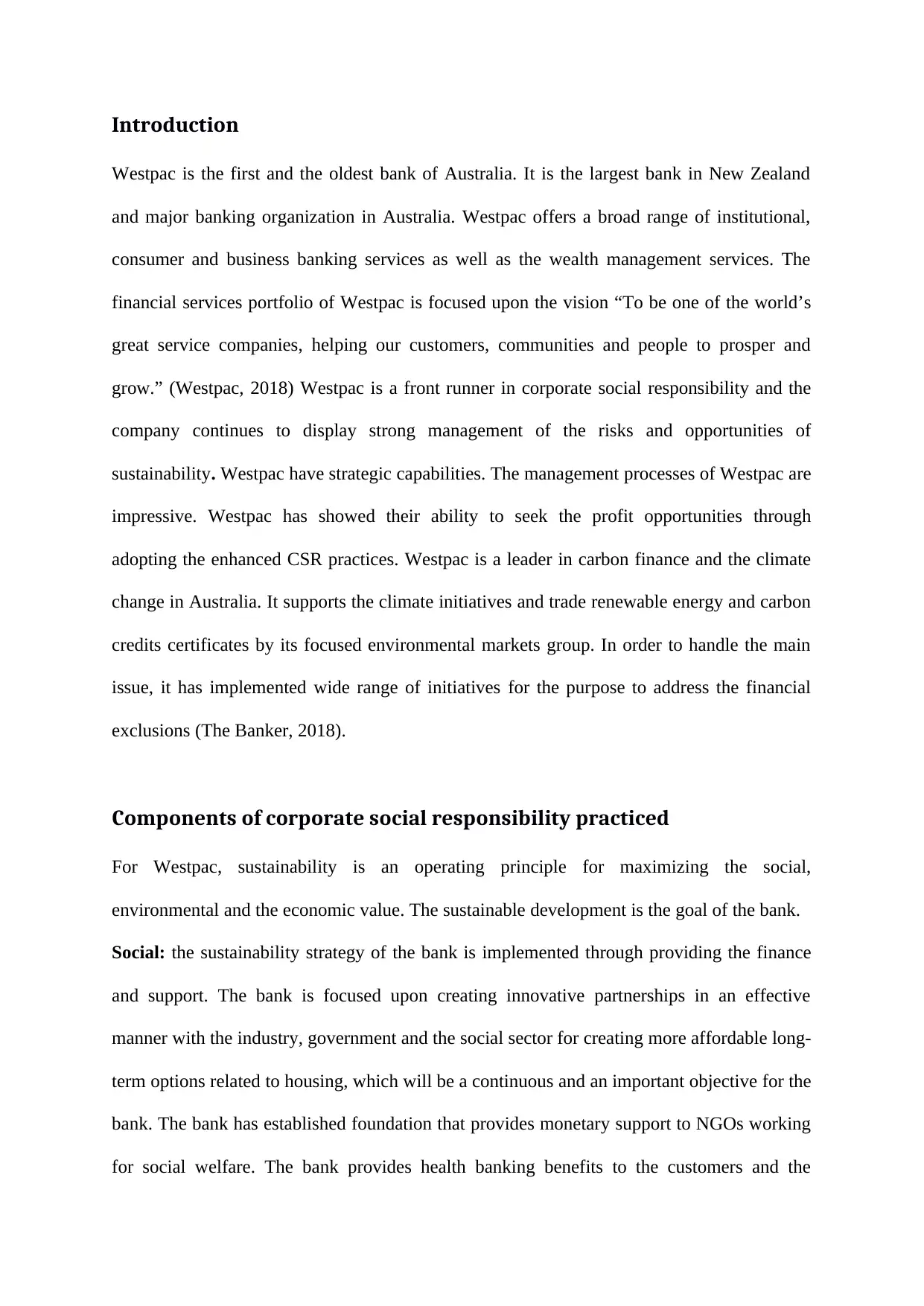
Introduction
Westpac is the first and the oldest bank of Australia. It is the largest bank in New Zealand
and major banking organization in Australia. Westpac offers a broad range of institutional,
consumer and business banking services as well as the wealth management services. The
financial services portfolio of Westpac is focused upon the vision “To be one of the world’s
great service companies, helping our customers, communities and people to prosper and
grow.” (Westpac, 2018) Westpac is a front runner in corporate social responsibility and the
company continues to display strong management of the risks and opportunities of
sustainability. Westpac have strategic capabilities. The management processes of Westpac are
impressive. Westpac has showed their ability to seek the profit opportunities through
adopting the enhanced CSR practices. Westpac is a leader in carbon finance and the climate
change in Australia. It supports the climate initiatives and trade renewable energy and carbon
credits certificates by its focused environmental markets group. In order to handle the main
issue, it has implemented wide range of initiatives for the purpose to address the financial
exclusions (The Banker, 2018).
Components of corporate social responsibility practiced
For Westpac, sustainability is an operating principle for maximizing the social,
environmental and the economic value. The sustainable development is the goal of the bank.
Social: the sustainability strategy of the bank is implemented through providing the finance
and support. The bank is focused upon creating innovative partnerships in an effective
manner with the industry, government and the social sector for creating more affordable long-
term options related to housing, which will be a continuous and an important objective for the
bank. The bank has established foundation that provides monetary support to NGOs working
for social welfare. The bank provides health banking benefits to the customers and the
Westpac is the first and the oldest bank of Australia. It is the largest bank in New Zealand
and major banking organization in Australia. Westpac offers a broad range of institutional,
consumer and business banking services as well as the wealth management services. The
financial services portfolio of Westpac is focused upon the vision “To be one of the world’s
great service companies, helping our customers, communities and people to prosper and
grow.” (Westpac, 2018) Westpac is a front runner in corporate social responsibility and the
company continues to display strong management of the risks and opportunities of
sustainability. Westpac have strategic capabilities. The management processes of Westpac are
impressive. Westpac has showed their ability to seek the profit opportunities through
adopting the enhanced CSR practices. Westpac is a leader in carbon finance and the climate
change in Australia. It supports the climate initiatives and trade renewable energy and carbon
credits certificates by its focused environmental markets group. In order to handle the main
issue, it has implemented wide range of initiatives for the purpose to address the financial
exclusions (The Banker, 2018).
Components of corporate social responsibility practiced
For Westpac, sustainability is an operating principle for maximizing the social,
environmental and the economic value. The sustainable development is the goal of the bank.
Social: the sustainability strategy of the bank is implemented through providing the finance
and support. The bank is focused upon creating innovative partnerships in an effective
manner with the industry, government and the social sector for creating more affordable long-
term options related to housing, which will be a continuous and an important objective for the
bank. The bank has established foundation that provides monetary support to NGOs working
for social welfare. The bank provides health banking benefits to the customers and the
Paraphrase This Document
Need a fresh take? Get an instant paraphrase of this document with our AI Paraphraser
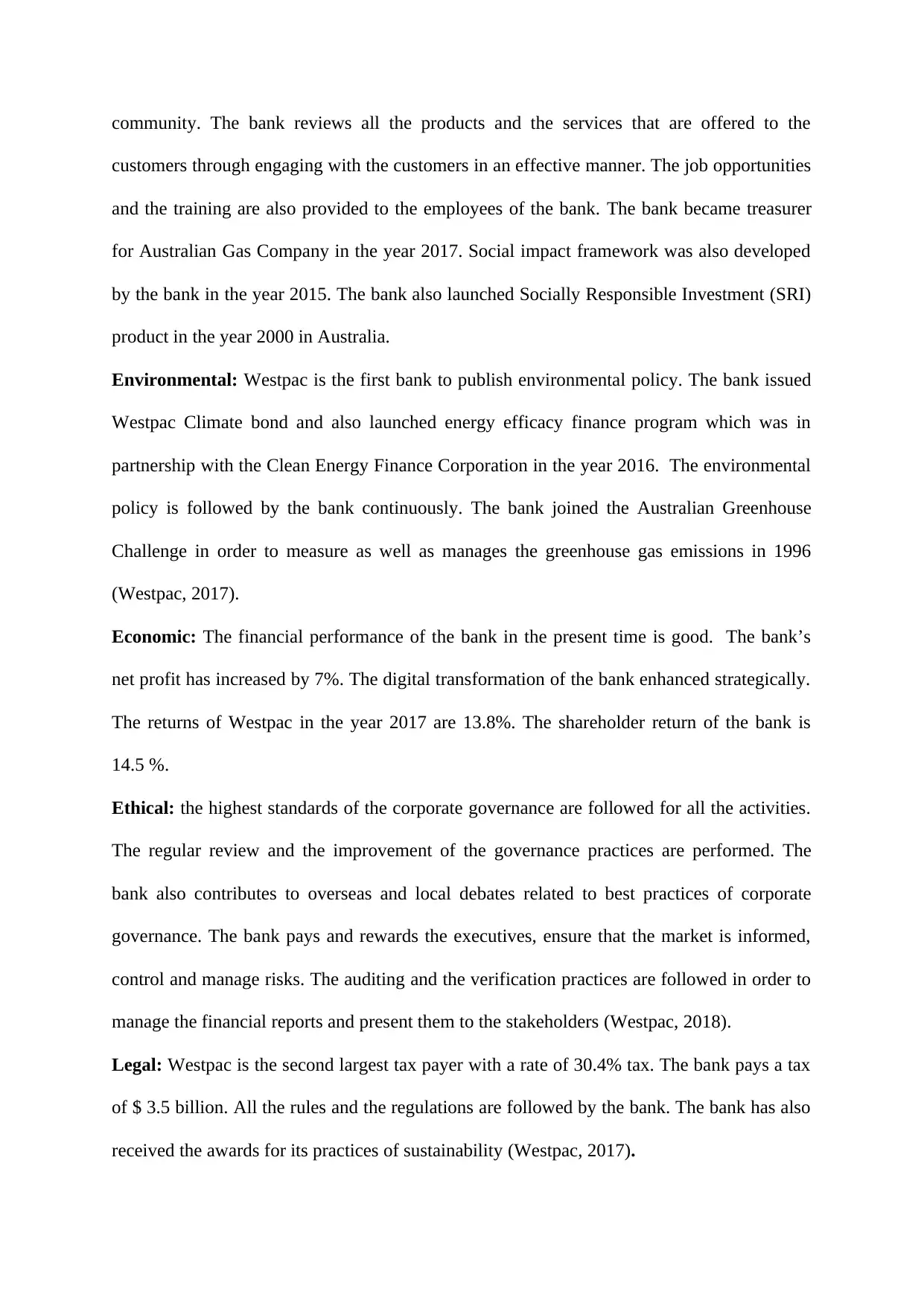
community. The bank reviews all the products and the services that are offered to the
customers through engaging with the customers in an effective manner. The job opportunities
and the training are also provided to the employees of the bank. The bank became treasurer
for Australian Gas Company in the year 2017. Social impact framework was also developed
by the bank in the year 2015. The bank also launched Socially Responsible Investment (SRI)
product in the year 2000 in Australia.
Environmental: Westpac is the first bank to publish environmental policy. The bank issued
Westpac Climate bond and also launched energy efficacy finance program which was in
partnership with the Clean Energy Finance Corporation in the year 2016. The environmental
policy is followed by the bank continuously. The bank joined the Australian Greenhouse
Challenge in order to measure as well as manages the greenhouse gas emissions in 1996
(Westpac, 2017).
Economic: The financial performance of the bank in the present time is good. The bank’s
net profit has increased by 7%. The digital transformation of the bank enhanced strategically.
The returns of Westpac in the year 2017 are 13.8%. The shareholder return of the bank is
14.5 %.
Ethical: the highest standards of the corporate governance are followed for all the activities.
The regular review and the improvement of the governance practices are performed. The
bank also contributes to overseas and local debates related to best practices of corporate
governance. The bank pays and rewards the executives, ensure that the market is informed,
control and manage risks. The auditing and the verification practices are followed in order to
manage the financial reports and present them to the stakeholders (Westpac, 2018).
Legal: Westpac is the second largest tax payer with a rate of 30.4% tax. The bank pays a tax
of $ 3.5 billion. All the rules and the regulations are followed by the bank. The bank has also
received the awards for its practices of sustainability (Westpac, 2017).
customers through engaging with the customers in an effective manner. The job opportunities
and the training are also provided to the employees of the bank. The bank became treasurer
for Australian Gas Company in the year 2017. Social impact framework was also developed
by the bank in the year 2015. The bank also launched Socially Responsible Investment (SRI)
product in the year 2000 in Australia.
Environmental: Westpac is the first bank to publish environmental policy. The bank issued
Westpac Climate bond and also launched energy efficacy finance program which was in
partnership with the Clean Energy Finance Corporation in the year 2016. The environmental
policy is followed by the bank continuously. The bank joined the Australian Greenhouse
Challenge in order to measure as well as manages the greenhouse gas emissions in 1996
(Westpac, 2017).
Economic: The financial performance of the bank in the present time is good. The bank’s
net profit has increased by 7%. The digital transformation of the bank enhanced strategically.
The returns of Westpac in the year 2017 are 13.8%. The shareholder return of the bank is
14.5 %.
Ethical: the highest standards of the corporate governance are followed for all the activities.
The regular review and the improvement of the governance practices are performed. The
bank also contributes to overseas and local debates related to best practices of corporate
governance. The bank pays and rewards the executives, ensure that the market is informed,
control and manage risks. The auditing and the verification practices are followed in order to
manage the financial reports and present them to the stakeholders (Westpac, 2018).
Legal: Westpac is the second largest tax payer with a rate of 30.4% tax. The bank pays a tax
of $ 3.5 billion. All the rules and the regulations are followed by the bank. The bank has also
received the awards for its practices of sustainability (Westpac, 2017).
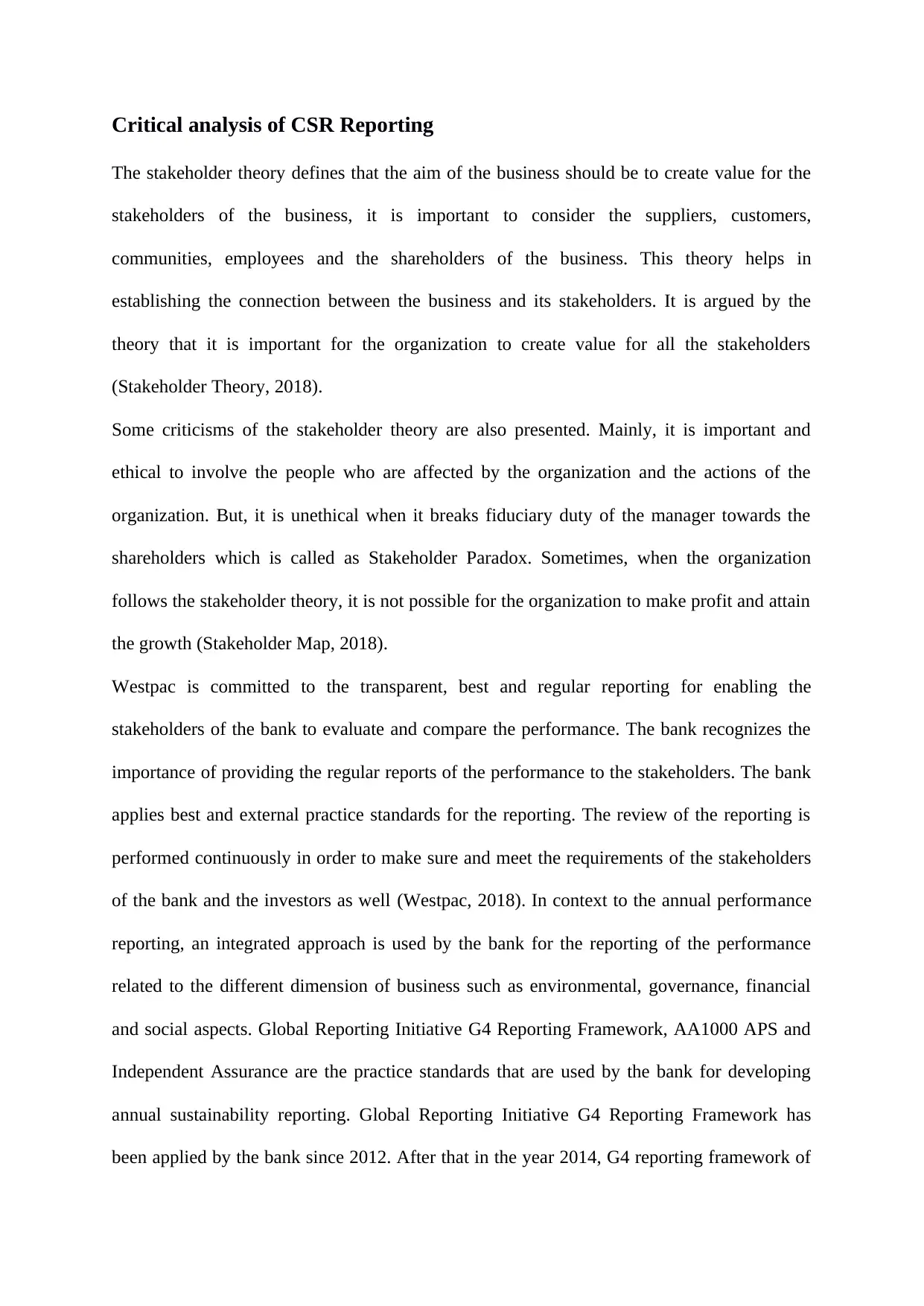
Critical analysis of CSR Reporting
The stakeholder theory defines that the aim of the business should be to create value for the
stakeholders of the business, it is important to consider the suppliers, customers,
communities, employees and the shareholders of the business. This theory helps in
establishing the connection between the business and its stakeholders. It is argued by the
theory that it is important for the organization to create value for all the stakeholders
(Stakeholder Theory, 2018).
Some criticisms of the stakeholder theory are also presented. Mainly, it is important and
ethical to involve the people who are affected by the organization and the actions of the
organization. But, it is unethical when it breaks fiduciary duty of the manager towards the
shareholders which is called as Stakeholder Paradox. Sometimes, when the organization
follows the stakeholder theory, it is not possible for the organization to make profit and attain
the growth (Stakeholder Map, 2018).
Westpac is committed to the transparent, best and regular reporting for enabling the
stakeholders of the bank to evaluate and compare the performance. The bank recognizes the
importance of providing the regular reports of the performance to the stakeholders. The bank
applies best and external practice standards for the reporting. The review of the reporting is
performed continuously in order to make sure and meet the requirements of the stakeholders
of the bank and the investors as well (Westpac, 2018). In context to the annual performance
reporting, an integrated approach is used by the bank for the reporting of the performance
related to the different dimension of business such as environmental, governance, financial
and social aspects. Global Reporting Initiative G4 Reporting Framework, AA1000 APS and
Independent Assurance are the practice standards that are used by the bank for developing
annual sustainability reporting. Global Reporting Initiative G4 Reporting Framework has
been applied by the bank since 2012. After that in the year 2014, G4 reporting framework of
The stakeholder theory defines that the aim of the business should be to create value for the
stakeholders of the business, it is important to consider the suppliers, customers,
communities, employees and the shareholders of the business. This theory helps in
establishing the connection between the business and its stakeholders. It is argued by the
theory that it is important for the organization to create value for all the stakeholders
(Stakeholder Theory, 2018).
Some criticisms of the stakeholder theory are also presented. Mainly, it is important and
ethical to involve the people who are affected by the organization and the actions of the
organization. But, it is unethical when it breaks fiduciary duty of the manager towards the
shareholders which is called as Stakeholder Paradox. Sometimes, when the organization
follows the stakeholder theory, it is not possible for the organization to make profit and attain
the growth (Stakeholder Map, 2018).
Westpac is committed to the transparent, best and regular reporting for enabling the
stakeholders of the bank to evaluate and compare the performance. The bank recognizes the
importance of providing the regular reports of the performance to the stakeholders. The bank
applies best and external practice standards for the reporting. The review of the reporting is
performed continuously in order to make sure and meet the requirements of the stakeholders
of the bank and the investors as well (Westpac, 2018). In context to the annual performance
reporting, an integrated approach is used by the bank for the reporting of the performance
related to the different dimension of business such as environmental, governance, financial
and social aspects. Global Reporting Initiative G4 Reporting Framework, AA1000 APS and
Independent Assurance are the practice standards that are used by the bank for developing
annual sustainability reporting. Global Reporting Initiative G4 Reporting Framework has
been applied by the bank since 2012. After that in the year 2014, G4 reporting framework of
⊘ This is a preview!⊘
Do you want full access?
Subscribe today to unlock all pages.

Trusted by 1+ million students worldwide
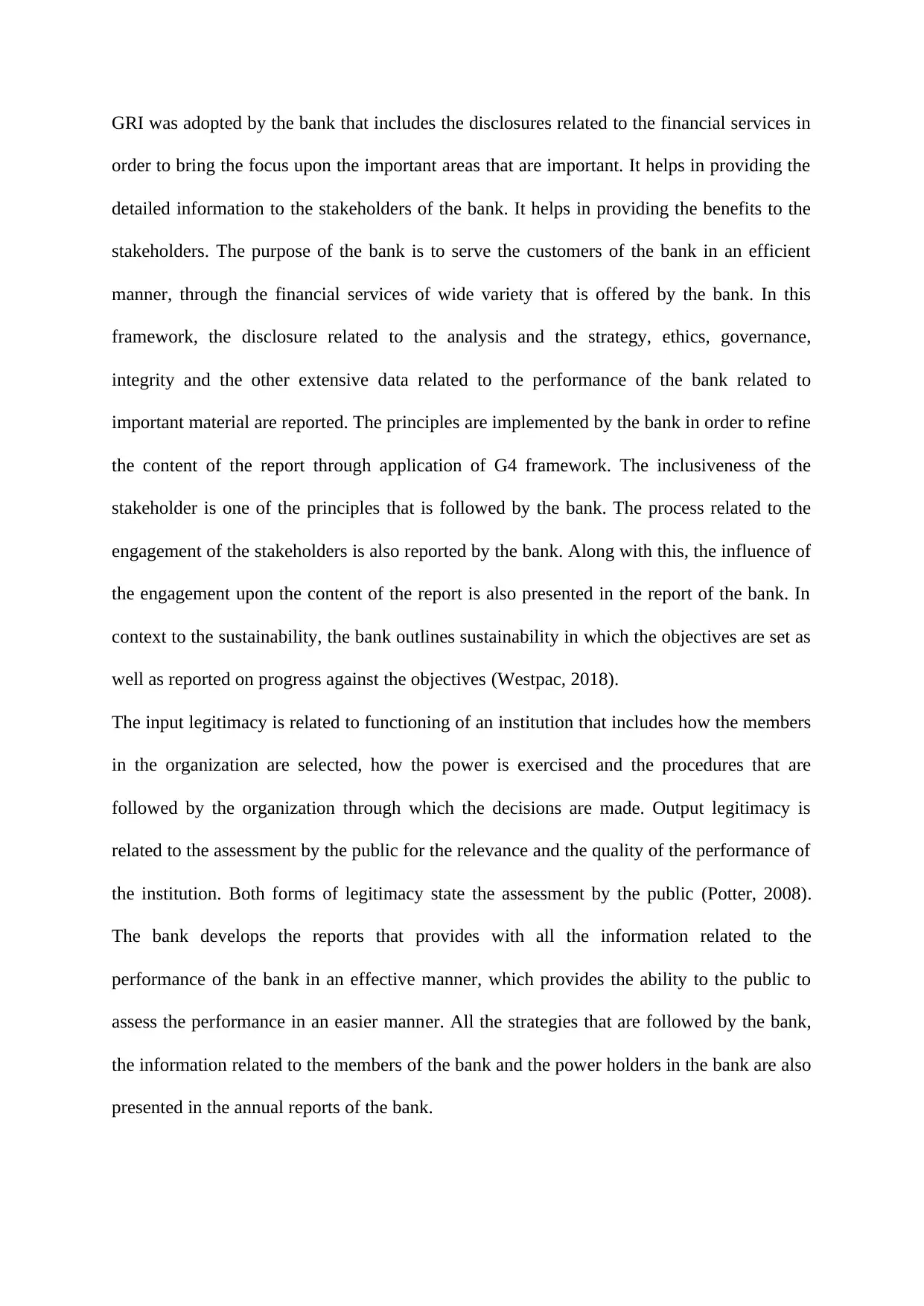
GRI was adopted by the bank that includes the disclosures related to the financial services in
order to bring the focus upon the important areas that are important. It helps in providing the
detailed information to the stakeholders of the bank. It helps in providing the benefits to the
stakeholders. The purpose of the bank is to serve the customers of the bank in an efficient
manner, through the financial services of wide variety that is offered by the bank. In this
framework, the disclosure related to the analysis and the strategy, ethics, governance,
integrity and the other extensive data related to the performance of the bank related to
important material are reported. The principles are implemented by the bank in order to refine
the content of the report through application of G4 framework. The inclusiveness of the
stakeholder is one of the principles that is followed by the bank. The process related to the
engagement of the stakeholders is also reported by the bank. Along with this, the influence of
the engagement upon the content of the report is also presented in the report of the bank. In
context to the sustainability, the bank outlines sustainability in which the objectives are set as
well as reported on progress against the objectives (Westpac, 2018).
The input legitimacy is related to functioning of an institution that includes how the members
in the organization are selected, how the power is exercised and the procedures that are
followed by the organization through which the decisions are made. Output legitimacy is
related to the assessment by the public for the relevance and the quality of the performance of
the institution. Both forms of legitimacy state the assessment by the public (Potter, 2008).
The bank develops the reports that provides with all the information related to the
performance of the bank in an effective manner, which provides the ability to the public to
assess the performance in an easier manner. All the strategies that are followed by the bank,
the information related to the members of the bank and the power holders in the bank are also
presented in the annual reports of the bank.
order to bring the focus upon the important areas that are important. It helps in providing the
detailed information to the stakeholders of the bank. It helps in providing the benefits to the
stakeholders. The purpose of the bank is to serve the customers of the bank in an efficient
manner, through the financial services of wide variety that is offered by the bank. In this
framework, the disclosure related to the analysis and the strategy, ethics, governance,
integrity and the other extensive data related to the performance of the bank related to
important material are reported. The principles are implemented by the bank in order to refine
the content of the report through application of G4 framework. The inclusiveness of the
stakeholder is one of the principles that is followed by the bank. The process related to the
engagement of the stakeholders is also reported by the bank. Along with this, the influence of
the engagement upon the content of the report is also presented in the report of the bank. In
context to the sustainability, the bank outlines sustainability in which the objectives are set as
well as reported on progress against the objectives (Westpac, 2018).
The input legitimacy is related to functioning of an institution that includes how the members
in the organization are selected, how the power is exercised and the procedures that are
followed by the organization through which the decisions are made. Output legitimacy is
related to the assessment by the public for the relevance and the quality of the performance of
the institution. Both forms of legitimacy state the assessment by the public (Potter, 2008).
The bank develops the reports that provides with all the information related to the
performance of the bank in an effective manner, which provides the ability to the public to
assess the performance in an easier manner. All the strategies that are followed by the bank,
the information related to the members of the bank and the power holders in the bank are also
presented in the annual reports of the bank.
Paraphrase This Document
Need a fresh take? Get an instant paraphrase of this document with our AI Paraphraser
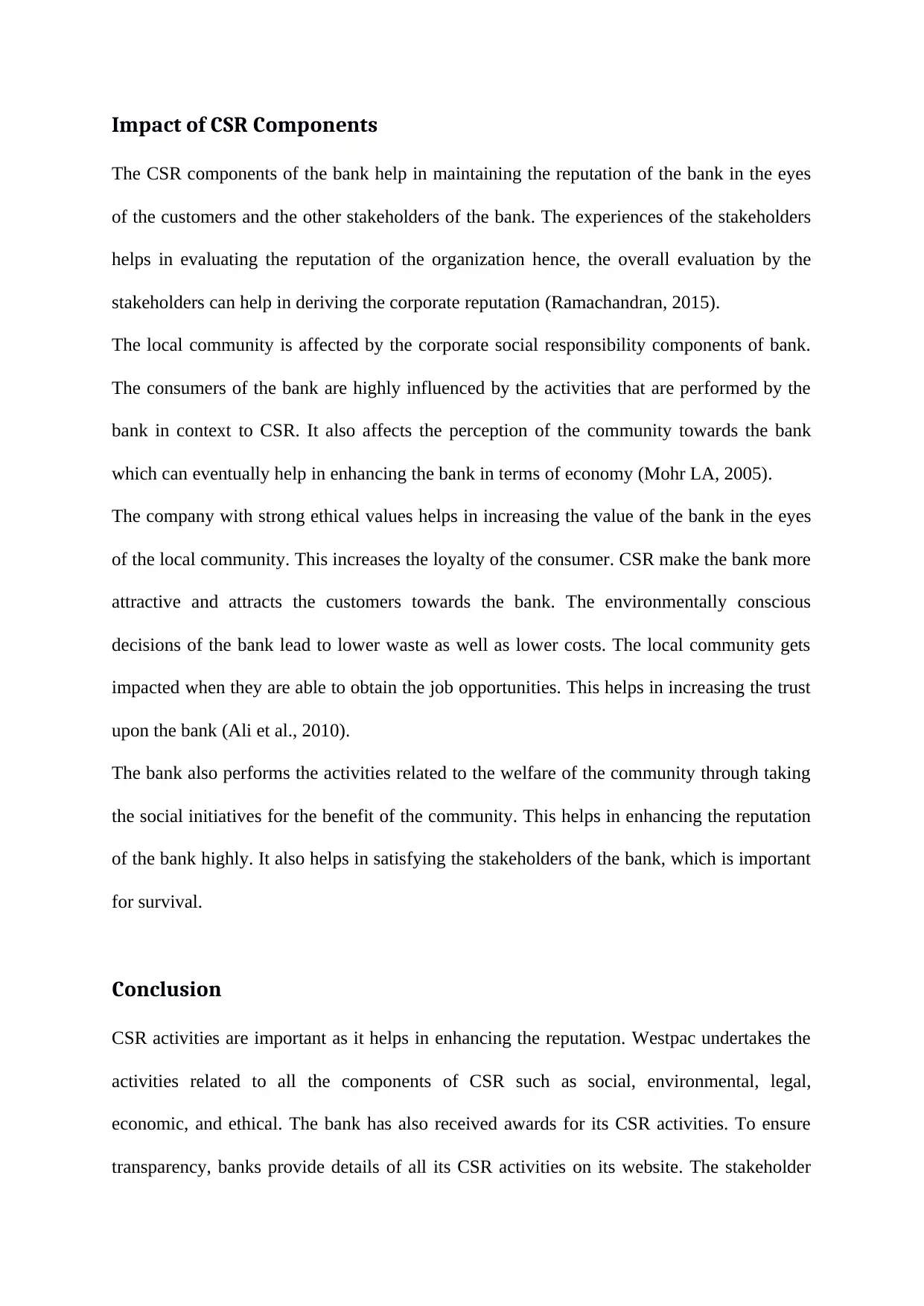
Impact of CSR Components
The CSR components of the bank help in maintaining the reputation of the bank in the eyes
of the customers and the other stakeholders of the bank. The experiences of the stakeholders
helps in evaluating the reputation of the organization hence, the overall evaluation by the
stakeholders can help in deriving the corporate reputation (Ramachandran, 2015).
The local community is affected by the corporate social responsibility components of bank.
The consumers of the bank are highly influenced by the activities that are performed by the
bank in context to CSR. It also affects the perception of the community towards the bank
which can eventually help in enhancing the bank in terms of economy (Mohr LA, 2005).
The company with strong ethical values helps in increasing the value of the bank in the eyes
of the local community. This increases the loyalty of the consumer. CSR make the bank more
attractive and attracts the customers towards the bank. The environmentally conscious
decisions of the bank lead to lower waste as well as lower costs. The local community gets
impacted when they are able to obtain the job opportunities. This helps in increasing the trust
upon the bank (Ali et al., 2010).
The bank also performs the activities related to the welfare of the community through taking
the social initiatives for the benefit of the community. This helps in enhancing the reputation
of the bank highly. It also helps in satisfying the stakeholders of the bank, which is important
for survival.
Conclusion
CSR activities are important as it helps in enhancing the reputation. Westpac undertakes the
activities related to all the components of CSR such as social, environmental, legal,
economic, and ethical. The bank has also received awards for its CSR activities. To ensure
transparency, banks provide details of all its CSR activities on its website. The stakeholder
The CSR components of the bank help in maintaining the reputation of the bank in the eyes
of the customers and the other stakeholders of the bank. The experiences of the stakeholders
helps in evaluating the reputation of the organization hence, the overall evaluation by the
stakeholders can help in deriving the corporate reputation (Ramachandran, 2015).
The local community is affected by the corporate social responsibility components of bank.
The consumers of the bank are highly influenced by the activities that are performed by the
bank in context to CSR. It also affects the perception of the community towards the bank
which can eventually help in enhancing the bank in terms of economy (Mohr LA, 2005).
The company with strong ethical values helps in increasing the value of the bank in the eyes
of the local community. This increases the loyalty of the consumer. CSR make the bank more
attractive and attracts the customers towards the bank. The environmentally conscious
decisions of the bank lead to lower waste as well as lower costs. The local community gets
impacted when they are able to obtain the job opportunities. This helps in increasing the trust
upon the bank (Ali et al., 2010).
The bank also performs the activities related to the welfare of the community through taking
the social initiatives for the benefit of the community. This helps in enhancing the reputation
of the bank highly. It also helps in satisfying the stakeholders of the bank, which is important
for survival.
Conclusion
CSR activities are important as it helps in enhancing the reputation. Westpac undertakes the
activities related to all the components of CSR such as social, environmental, legal,
economic, and ethical. The bank has also received awards for its CSR activities. To ensure
transparency, banks provide details of all its CSR activities on its website. The stakeholder
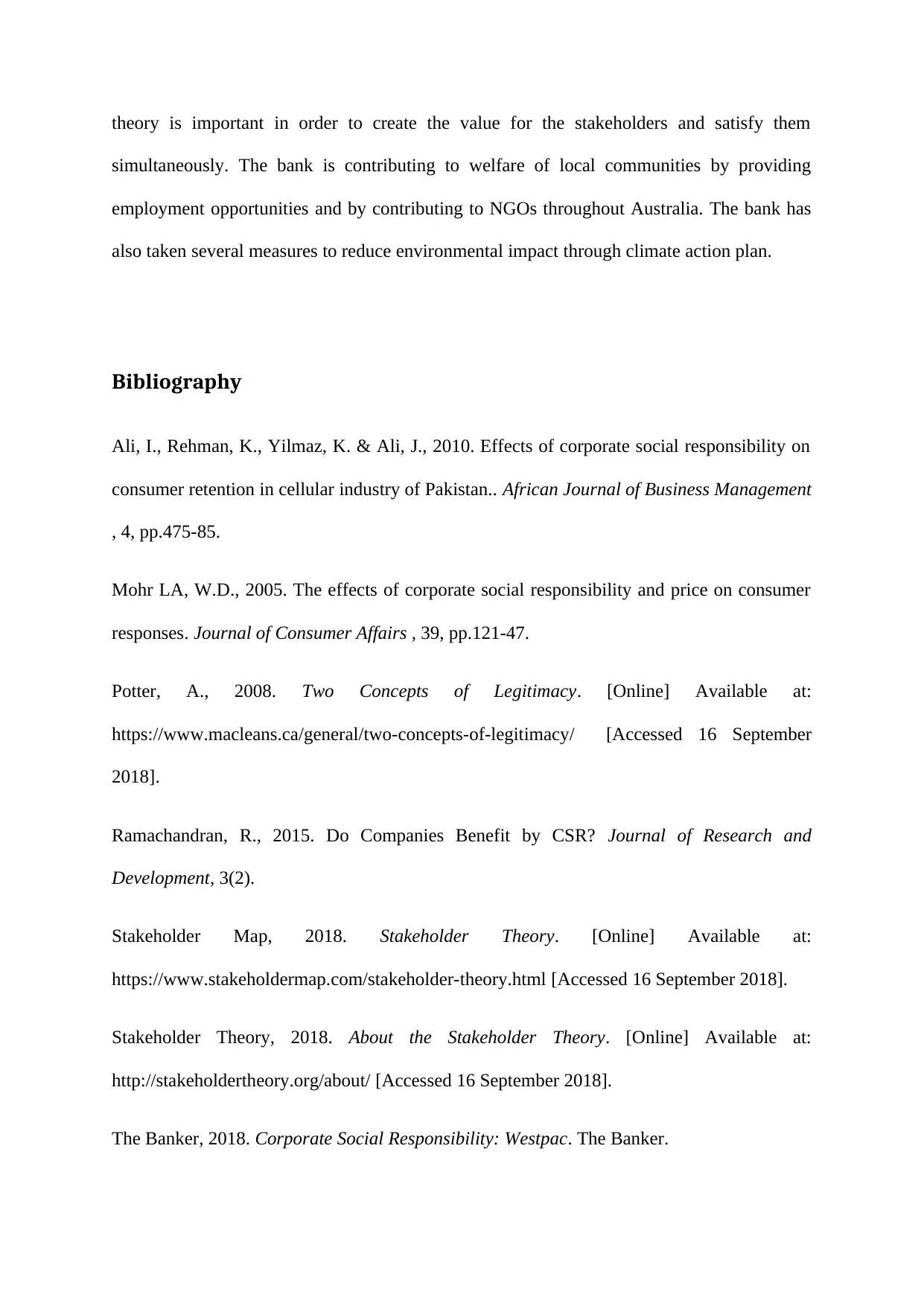
theory is important in order to create the value for the stakeholders and satisfy them
simultaneously. The bank is contributing to welfare of local communities by providing
employment opportunities and by contributing to NGOs throughout Australia. The bank has
also taken several measures to reduce environmental impact through climate action plan.
Bibliography
Ali, I., Rehman, K., Yilmaz, K. & Ali, J., 2010. Effects of corporate social responsibility on
consumer retention in cellular industry of Pakistan.. African Journal of Business Management
, 4, pp.475-85.
Mohr LA, W.D., 2005. The effects of corporate social responsibility and price on consumer
responses. Journal of Consumer Affairs , 39, pp.121-47.
Potter, A., 2008. Two Concepts of Legitimacy. [Online] Available at:
https://www.macleans.ca/general/two-concepts-of-legitimacy/ [Accessed 16 September
2018].
Ramachandran, R., 2015. Do Companies Benefit by CSR? Journal of Research and
Development, 3(2).
Stakeholder Map, 2018. Stakeholder Theory. [Online] Available at:
https://www.stakeholdermap.com/stakeholder-theory.html [Accessed 16 September 2018].
Stakeholder Theory, 2018. About the Stakeholder Theory. [Online] Available at:
http://stakeholdertheory.org/about/ [Accessed 16 September 2018].
The Banker, 2018. Corporate Social Responsibility: Westpac. The Banker.
simultaneously. The bank is contributing to welfare of local communities by providing
employment opportunities and by contributing to NGOs throughout Australia. The bank has
also taken several measures to reduce environmental impact through climate action plan.
Bibliography
Ali, I., Rehman, K., Yilmaz, K. & Ali, J., 2010. Effects of corporate social responsibility on
consumer retention in cellular industry of Pakistan.. African Journal of Business Management
, 4, pp.475-85.
Mohr LA, W.D., 2005. The effects of corporate social responsibility and price on consumer
responses. Journal of Consumer Affairs , 39, pp.121-47.
Potter, A., 2008. Two Concepts of Legitimacy. [Online] Available at:
https://www.macleans.ca/general/two-concepts-of-legitimacy/ [Accessed 16 September
2018].
Ramachandran, R., 2015. Do Companies Benefit by CSR? Journal of Research and
Development, 3(2).
Stakeholder Map, 2018. Stakeholder Theory. [Online] Available at:
https://www.stakeholdermap.com/stakeholder-theory.html [Accessed 16 September 2018].
Stakeholder Theory, 2018. About the Stakeholder Theory. [Online] Available at:
http://stakeholdertheory.org/about/ [Accessed 16 September 2018].
The Banker, 2018. Corporate Social Responsibility: Westpac. The Banker.
⊘ This is a preview!⊘
Do you want full access?
Subscribe today to unlock all pages.

Trusted by 1+ million students worldwide
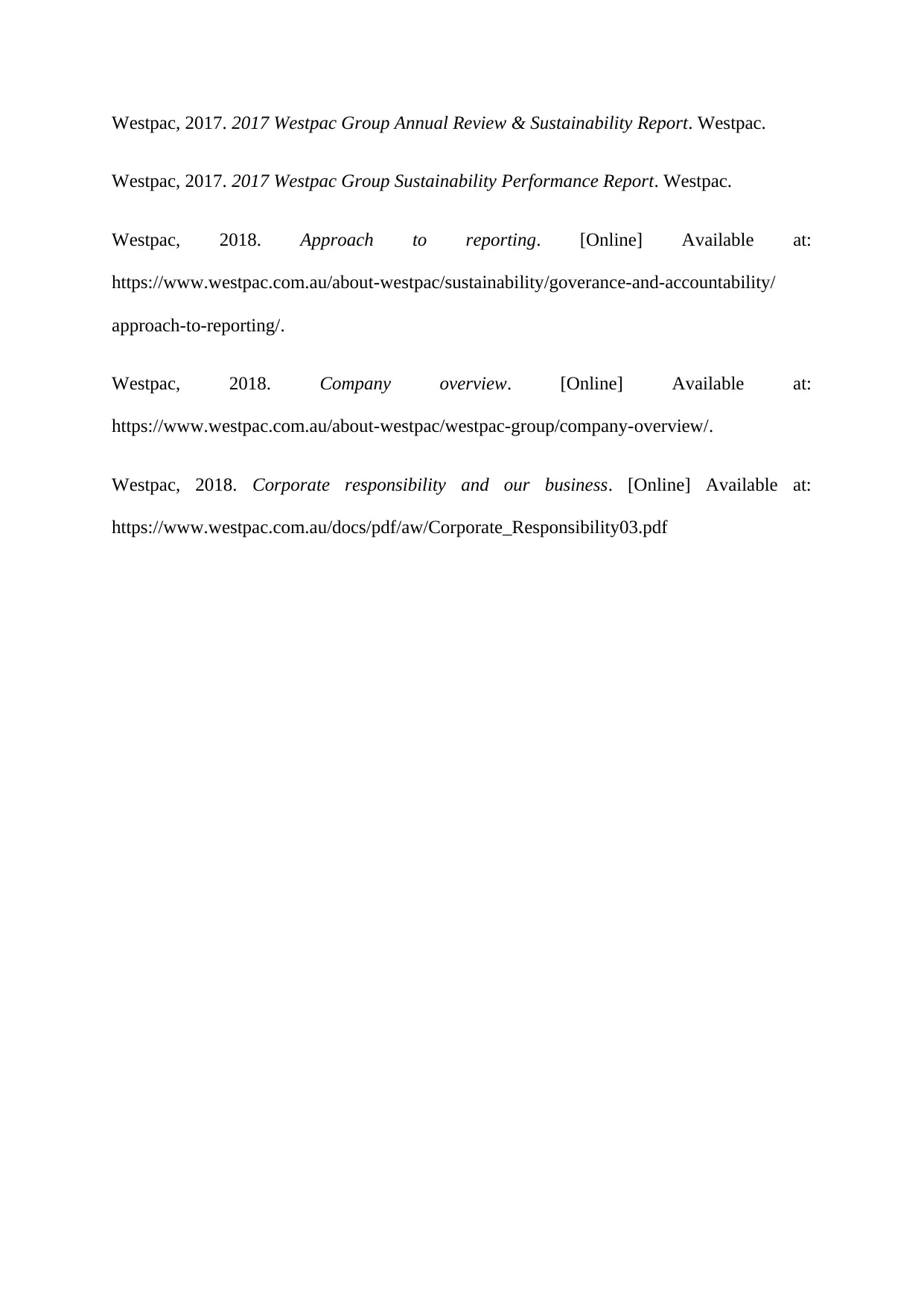
Westpac, 2017. 2017 Westpac Group Annual Review & Sustainability Report. Westpac.
Westpac, 2017. 2017 Westpac Group Sustainability Performance Report. Westpac.
Westpac, 2018. Approach to reporting. [Online] Available at:
https://www.westpac.com.au/about-westpac/sustainability/goverance-and-accountability/
approach-to-reporting/.
Westpac, 2018. Company overview. [Online] Available at:
https://www.westpac.com.au/about-westpac/westpac-group/company-overview/.
Westpac, 2018. Corporate responsibility and our business. [Online] Available at:
https://www.westpac.com.au/docs/pdf/aw/Corporate_Responsibility03.pdf
Westpac, 2017. 2017 Westpac Group Sustainability Performance Report. Westpac.
Westpac, 2018. Approach to reporting. [Online] Available at:
https://www.westpac.com.au/about-westpac/sustainability/goverance-and-accountability/
approach-to-reporting/.
Westpac, 2018. Company overview. [Online] Available at:
https://www.westpac.com.au/about-westpac/westpac-group/company-overview/.
Westpac, 2018. Corporate responsibility and our business. [Online] Available at:
https://www.westpac.com.au/docs/pdf/aw/Corporate_Responsibility03.pdf
1 out of 10
Related Documents
Your All-in-One AI-Powered Toolkit for Academic Success.
+13062052269
info@desklib.com
Available 24*7 on WhatsApp / Email
![[object Object]](/_next/static/media/star-bottom.7253800d.svg)
Unlock your academic potential
Copyright © 2020–2026 A2Z Services. All Rights Reserved. Developed and managed by ZUCOL.





